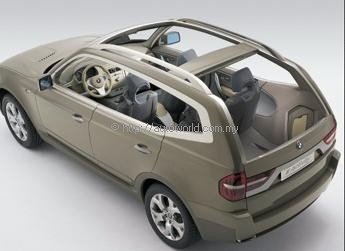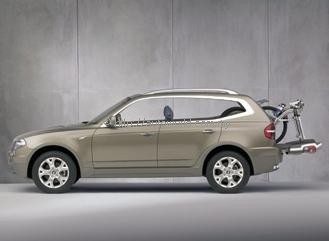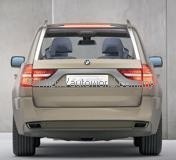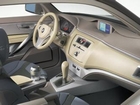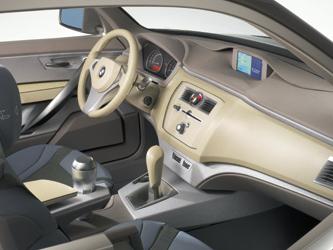xActivity Vehicle = BMW X3
At the 2003 North American International Auto Show in Detroit, the world will get a preview of the BMW X3. It will be in the form of a concept model that is called the xActivity vehicle and the first official pictures show much similarity to the spy photos that have appeared earlier this year.
However, BMW doesn’t specifically say this will be the X3 and instead says that it “suggests where BMW is heading as far as the expansion of the X family is concerned”. That’s the same sort of obtuse statement they made the last time when they previewed the X5 in Detroit as a concept model!
The X3 project is no secret, of course, and even back in October, BMW issued a press release to announce it when the company signed a collaboration agreement with Steyr-Daimler-Puch, an Austrian company (part of the Magna group) which specialises in all-terrain vehicle engineering. It builds the Mercedes-Benz G-Wagen and M-Class as well as the E-Class with 4WD and also the Jeep Cherokee.
In working with Steyr, BMW will do the development concept of the X3 and pass this to Magna Steyr Engineering for turning into a production model. Production will be taken over by Magna Steyr which will spend 500 million euros for the project and set up a new assembly building to make the X3.
“Those who work alone can only accumulate; but those who cooperate intelligently can multiply”, said Professor Dr.-Ing. Joachim Milberg, Chairman of the Board of Management of BMW AG. “Our cooperation with Magna Steyr increases the speed and flexibility of our company and is a further milestone in the consistent implementation of our product offensive.”
While Steyr will be handling the production side of the project, BMW emphasises that it will still have lots of control. As with all BMW vehicles, some elements will use BMW module units. All the vehicle components in the X3 will be signed off by the BMW Group’s Development Departments. In addition, core areas of competence, such as design, engine construction, purchasing and customer service will remain the sole responsibility of the BMW Group.
Dr.-Ing. Burkhard Göschel, Member of the Board of BMW AG, Development added: “We are making sure, right in the development process, that the X3 will be a BMW through and through. Components where BMW is a step ahead in terms of expertise will continue to be developed by BMW engineers solely.”
Of the xActivity, BMW notes that this is another of its Sports Activity Vehicles (SAV) and is ‘a perfect combination of sporty driving dynamics, enormous versatility and the inimitable pleasure of driving an open-top vehicle’.
From the outside, the most striking feature of the xActivity is its unusual roof construction. As a so-called “frame-structure convertible”, the vehicle – which by the way has a monocoque construction – perfectly combines the excitement of a convertible and the robust looks of an SAV. Longitudinal members on both sides connect the A-pillars with the rear end. The space in-between is open so that the passengers are able to enjoy the sun and the wind, letting them enjoy for the forthcoming outdoor activities. There are no B- and C-pillars which emphasizes the xActivity’s particularly sporting character.
Whether this styling feature will also be in the production X3 remains to be seen although from the structural point of view, it is now possible to provide sufficient side impact strength. That’s why you see some of the latest cars having no B-pillars.
Strong bumpers and flared wheel arches further accentuate the xActivity’s robust and agile appearance, as one would expect from an SAV. The proportions so typical of BMW, like the long wheelbase and the short overhangs, give the xActivity a dynamic and athletic appearance.
The dynamic and open appearance is further accentuated by the striking side panels. The waistline rises from the headlight clusters towards the rear end with convex and concave surfaces below conveying a strong dynamic impression. Whenever these concave/convex surfaces meet, they create striking longitudinal edges on the side panels giving the impression of strong and broad shoulders.
Viewed from the rear, the observer will also notice the unique character of the xActivity. Distinctive horizontal lines give the vehicle an agile appearance from behind and contribute to the muscular stern. The L-shaped taillights so typical of BMW have been reinterpreted. Under the clear red glass, one sees the taillights in LED design and the reflectors which give a technologically futuristic appearance.
The concept vehicle’s high degree of functionality is borne out by surprising details. The unconventional loading system in particular does great credit to the name “Sports Activity Vehicle”. As soon as you open the tailgate, the cargo – two mountain bikes for example – is partially ejected by a cleverly devised system, enabling the passengers to easily remove their sports equipment and to continue their ‘adventure’ on two wheels. Further practical details are the two integrated backpacks. These are a perfect match in terms of design, colour and material, are well integrated into the cargo area’s side panels and are easy to remove.
The interior design of the xActivity is sporting and versatile without foregoing the benefits of comfort and individuality. The play of concave and convex surfaces on the outside is continued in the interior and contributes to the modern ambience. Individual shapes are clearly separated from each other by distinctive curves and edges.
The taut surfaces give the individual elements an air of poise and a distinctive character. Vertical accents, for example on the door handles and the centre console, contribute to the interior’s outdoor-specific spacious and open appearance.
The intentional use of light and shade conveys the impression that individual components are ‘weightless’ and, at the same time, gives the load-bearing elements the appropriate strength. For example, this design language has been carried through to common details such as the gearshift lever. In keeping with the design language of the vehicle as a whole, the asymmetric gearshift lever knob seems as if it were floating.
The interior elements are arranged as modules, creating a harmonious atmosphere that invites activity and relaxed well-being alike. Operating controls are intelligently combined; for example, the single-button control
for all climate functions, and provide for a well-structured cockpit.
The most important thing for the SAV-typical driving experience is, however, the “command position” – the high seating position – which is a characteristic of its SAVs and gives the driver and passengers an excellent view of the vehicle and its surroundings.
The use of state-of-the-art technology underlines the revolutionary character of the concept vehicle. Through the use of so-called “smart materials”, the seats and surfaces have themselves become operational controls, so that seat adjustment controls are no longer visible. These innovative pressure-sensitive materials make designer’s dreams come true and provide the perfect combination of form and function.
Components subject to wear and tear such as the seats have been provided with robust neoprene and neoprene mesh. The seat shoulders come in “Smoke-Grey”, whilst the actual seating area made of neoprene mesh shows in a most sporting manner its texture in “Aloe” and “Smoke-Grey.
It has been speculated that the X3 will use some of the powertrains of the 3-Series and for the 4.55-metre long xActivity, the engine is the familiar 3.0-litre straight-six which delivers a maximum output of 170 kW/231 bhp and beefy torque of 300 Nm.
Other elements of the drivetrain are likely to follow those of the all-wheel drive X5 although details remain limited for now. However, there is mention that, rather than using a mechanical differential lock, has an intelligent electronic ADB-X differential lock which saves weight substantially. Through this technology, BMW says disadvantages can be eliminated in terms of handling agility, fuel economy and safety without foregoing the benefits of the off-road capability.
The xActivity (and presumably the X3) also has Hill Descent Control which is now common in Land Rovers (Land Rover was once owned by BMW). This electronic feature makes driving downhill on any kind of terrain safe and easy, almost like it is done by a pro off-roader.
The X3 is expected to go on sale in 2003, which is just around the corner. However, even before it has officially appeared in showrooms, BMW has had to fight a Mitsubishi dealer in court over an internet domain name which is bmwx3.com! Apparently, the dealer in the US has established the website in May 2001 and BMW had attempted to negotiate with him to acquire it from the end of that year.
Perhaps sensing an opportunity to make a ‘fast buck’ from the German carmaker, the dealer refused at first. Later, he asked for a car as compensation but BMW offered him US$300 as reimbursement for the internet registration fee. He rejected the offer so BMW took the case to a US Arbitration and Mediation Centre using the Uniform Domain Name Dispute Resolution Policy.
The findings were that the dealer had set up the website as ‘an obvious attempt to mislead consumers looking for information about the BMW X3 model’. The Centre ruled in October this year that ‘the Complainant [BMW] stated that the Respondent is involved in selling Mitsubishi cars, which is a competing car brand. Therefore the registration and use of the domain name was for the purpose of disrupting the business of the Complainant, since it hinders the Complainant from promoting or advertising its new product under the suitable domain name’. And this conclusion saw BMW getting control of bmwx3.com.





